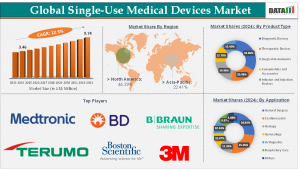Single-Use Medical Devices Market Set to Hit $9.74B by 2033 | Exclusive Report by DataM Intelligence
Single-use medical devices gain traction globally as hospitals prioritize hygiene, safety, and efficiency in patient care.
Download Exclusive Sample Report Here:https://www.datamintelligence.com/download-sample/single-use-medical-devices-market
Market Overview and Drivers
Single-use medical devices, as the name suggests, are intended for one-time use only. This includes products like catheters, syringes, infusion sets, diagnostic equipment, and surgical instruments. Their usage helps prevent cross-contamination and reduces the burden of sterilization processes in hospitals and clinics.
Key factors propelling the market growth include:
Increased infection control awareness: Especially post-pandemic, hospitals have prioritized preventing infections with stricter hygiene protocols.
Rising chronic illnesses and surgeries: A surge in cardiovascular diseases, diabetes, and cancer has increased surgical interventions that often rely on sterile single-use instruments.
Technological innovation: Companies are integrating smarter materials and features into single-use devices to enhance usability and comfort.
Growing elderly population: With age comes higher susceptibility to infections and diseases, leading to greater demand for safe and sterile tools.
However, this growth comes with environmental concerns. The volume of medical waste generated through disposable devices is a major issue, prompting the industry to consider biodegradable or recyclable alternatives.
Regional Outlook
North America
North America holds a dominant position in the global market. A well-established healthcare infrastructure, high adoption of advanced technologies, and increasing outpatient surgical procedures contribute to the region’s leadership. Additionally, reimbursement policies and strong regulatory support further drive product adoption.
Europe
European countries are also investing heavily in healthcare infrastructure and public health safety. Countries like Germany, the UK, and France are showing increasing interest in eco-friendly single-use solutions. Government initiatives encouraging hospital hygiene compliance have had a positive effect on device uptake.
Asia-Pacific
Asia-Pacific is the fastest-growing market, driven by expanding healthcare services in emerging economies. Rising population, urbanization, and increasing medical tourism in countries like India, China, and Japan are fueling demand. Moreover, governments are allocating larger healthcare budgets, boosting hospital capacity and disposable medical supply procurement.
Key Players
Medtronic
BD
B. Braun SE
Terumo Corporation
Smith+Nephew
Boston Scientific Corporation
3M
Abbott
NIPRO
Cardinal Health
Latest News
Latest News of USA
In the United States, the single-use medical devices industry is witnessing increased investment and product expansion. Several U.S.-based manufacturers are scaling up operations to meet growing hospital demand. The emphasis has shifted toward high-performance, disposable surgical tools that reduce operation times and post-operative complications.
At the same time, rising concerns over new tariff regulations have prompted U.S. manufacturers to review their supply chains. Some firms are exploring local sourcing of materials and alternative manufacturing hubs to avoid cost increases. This shift may lead to an eventual reduction in dependence on overseas imports and an emphasis on local innovation.
Hospitals and outpatient centers are also embracing subscription-based supply models. These agreements allow for automated resupply of disposable kits and instruments, ensuring consistency in hygiene standards while improving inventory management.
Latest News of Japan
Japan is making strategic policy moves to encourage medical innovation, including reforms to accelerate the approval and market access for novel single-use medical devices. In light of supply chain disruptions in previous years, the government is emphasizing local manufacturing and streamlining regulatory processes for medical startups.
Additionally, Japan’s Ministry of Health is promoting the development of biodegradable and environmentally friendly single-use devices. With growing public and institutional awareness of sustainability, many companies are prioritizing R&D in this direction.
Another emerging trend in Japan is the integration of wearable single-use diagnostic tools for elderly care. With one of the world's most aging populations, Japan is leading in the development of sensor-based, disposable monitors to track vital signs, detect falls, or manage chronic conditions from home.
Market Segmentation:
By Product Type: Diagnostic Devices, Therapeutic Devices, Surgical Instruments, Consumables and Accessories, Infusion and Injection Devices.
By Application: General Surgery, Cardiovascular, Urology, Gynecology, Orthopedics, Respiratory Care, Others.
By End-User: Hospitals, Ambulatory Surgical Centers , Clinics, Home Healthcare, Diagnostic Centers and Labs, Others.
Conclusion
The global single-use medical devices market is on a steep upward trajectory, supported by innovation, regulatory reform, and a shift in medical best practices. While sustainability remains a challenge, the industry is already moving toward greener solutions without compromising safety.
Regions like North America and Europe are adopting these devices as a gold standard, while the Asia-Pacific region, led by countries like Japan and China, is rapidly catching up. With growing awareness about infection prevention, a surge in healthcare demand, and continuous innovation, single-use medical devices are set to play an increasingly crucial role in modern medicine.
Organizations that prioritize not just product efficiency but also ecological responsibility and affordability will lead the market in the years ahead.
Stay informed with the latest industry insights-start your subscription now: https://www.datamintelligence.com/reports-subscription
Related Reports:
Single-Use Medical Devices Reprocessing Market
Self-care Medical Devices Market
Sai Kumar
DataM Intelligence 4market Research LLP
+1 877-441-4866
email us here
Visit us on social media:
LinkedIn
X
Legal Disclaimer:
EIN Presswire provides this news content "as is" without warranty of any kind. We do not accept any responsibility or liability for the accuracy, content, images, videos, licenses, completeness, legality, or reliability of the information contained in this article. If you have any complaints or copyright issues related to this article, kindly contact the author above.
OneWell Health Care Expands to Georgia, Launching Pediatric, Veteran, and Private Home Care Services
Oliver Domínguez Releases 'Lost' on July 4: A Rock & World Music Anthem of Healing and Self-Discovery
Medical Supplierz Introduces AI-Powered Search to Enhance B2B Buyer-Supplier Matching
Więcej ważnych informacji
 Jedynka Newserii
Jedynka Newserii

 Jedynka Newserii
Jedynka Newserii

Konsument

Proces deregulacji nie dotyczy branży tytoniowej. Jest propozycja kolejnej ustawy w ciągu kilku miesięcy
Najpierw wprowadzenie podatku akcyzowego na saszetki nikotynowe, potem propozycja przepisów, które zmierzają do wycofania tych produktów z rynku – przedstawiciele środowisk biznesowych podkreślają, że przygotowywane przez resort zdrowia przepisy wprowadzają chaos legislacyjny w branży tytoniowej. To tym bardziej dziwi przedsiębiorców, że stoi w opozycji do prowadzonego przez rząd procesu deregulacji w gospodarce. W dodatku może mieć negatywne skutki dla budżetu państwa i doprowadzić do skokowego wzrostu szarej strefy.
Bankowość
Grzyby rozkładające tekstylia nagrodzone w konkursie ING. 1 mln zł trafi na innowacyjne projekty dla zrównoważonych miast

Firma Myco Renew, która opracowała technologię rozkładającą tekstylia za pomocą grzybów, została laureatem siódmej edycji Programu Grantowego ING. Motywem przewodnim konkursu skierowanego do start-upów i młodych naukowców był tym razem zrównoważony rozwój miast i społeczności. Łącznie na nagrodzone innowacyjne projekty trafił 1 mln zł. Wśród nich są także bezzałogowe statki powietrzne dostarczające defibrylatory czy system do zbierania deszczówki w blokach.
Prawo
Trwają próby wzmocnienia dialogu społecznego. Niespokojne czasy wymuszają większe zaangażowanie społeczeństwa w podejmowanie decyzji

Według zapowiedzi szefowej Komisji Europejskiej Ursuli von der Leyen głos partnerów społecznych i dialog społeczny będą stały w centrum procesu decyzyjnego w Europie. Taki jest cel podpisanego w marcu Paktu na rzecz europejskiego dialogu społecznego. Potrzeba wzmocnienia głosu społeczeństwa jest również podkreślana na forum krajowym. Rząd planuje reformę Rady Dialogu Społecznego, by usprawnić pracę tej instytucji, a przedsiębiorcy wzywają do rzetelnego konsultowania ze stroną społeczną ustaw, które wychodzą z rządu.
Partner serwisu
Szkolenia

Akademia Newserii
Akademia Newserii to projekt, w ramach którego najlepsi polscy dziennikarze biznesowi, giełdowi oraz lifestylowi, a także szkoleniowcy z wieloletnim doświadczeniem dzielą się swoją wiedzą nt. pracy z mediami.








.gif)

 |
| |
| |
|